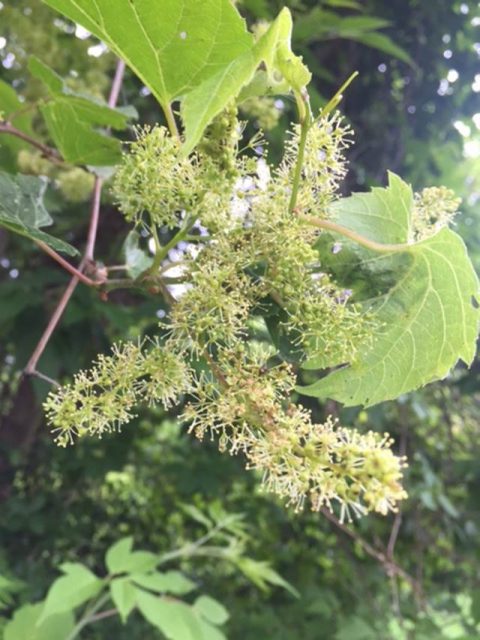By Terence Bradshaw
June 10, 2017
CPS crop consultant Eric Boire sent me this picture yesterday of what, on first glance, looks like a first generation codling moth larvae burrowed into an apple at about 10-12 mm growth stage:

Figure 1. European apple sawfly damage posing as codling moth injury.
We have seen this a lot in the UVM orchards, especially the organic section. What we are looking at is European apple sawfly (EAS) damage. You can see the characteristics squiggly scar right below the hole, but sometimes larvae aren’t content feeding on one apple and will exit one fruit and enter an adjoining one- all the more reason to thin your fruit down to singles per spur early. There isn’t a lot to do to manage them at this stage except hand-thin the affected fruitlets and remove them from the orchard to lower nest year’s population-we’ve done this with seemingly millions of these in the organic orchards at the Hort Farm. The maddening thing about seeing this damage now in a commercial orchard is that we have caught very few EAS in our traps all over the state, including in this orchard. Traps used for monitoring EAS are unbaited white sticky cards that are designed to mimic a large blossom.

Figure 2. EAS trap.
We have used a trap for decades at the UVM farm that have been quite effective, but this year, we started using a smaller, more inexpensive trap that has less surface area and less ‘sticky’ and seems to be missing these pests during aa time when monitoring would help deliver actionable recommendations for their management. Long, extended bloom periods like this year’s make EAS management more difficult as well.
Codling moth will do similar damage but always later in the season, usually when fruit are over 20 mm in size. CM larvae are just starting to hatch now in the Champlain and Connecticut Valleys, so a targeted application at them would be prudent, as I’ve mentioned in recent posts.
Another oddity that came to me was the presence of crown gall in some trees at a commercial orchard that prompted me to check some dying trees we have at the UVM orchard on the same rootstock from the same nursery:

Figure 3. Crown gall on apple.
Notice the warty growths on the roots. This tree was dead, and had little to no root growth since it was planted in 2016. The affected rootstock was Geneva 935; keep an eye out for declining trees on that (or any) rootstock. Crown gall is caused by a bacterium, Agrobacterium tumefaciens, which affects many types of plants. It is not uncommon, but generally becomes pathenogenic when plants are damaged, e.g., from cold (commonly seen in grape) or from nursery digging. The best defense is to use disease-free plants. A careful inspection of roots at planting time should be performed to make sure you’re not putting a dying tree in the ground to start with. A. tumefaciens is one of nature’s original agents for horizontal gene transfer, a natural GMO, if you will, as it inserts its own DNA into the host plant which responds by growing the galls or ‘tumors’ as shown in the picture. AAs an aside, early GM breeding used this characteristic of the bacterium to transfer genes to new plants, although more precise methods are typically used these days for that task. There is no chemical management for crown gall in apple, basically we need to plant clean trees and keep them healthy through good cultural practices. A good fact sheet on the disease is available at: http://ohioline.osu.edu/factsheet/plpath-fru-19
If you were affected by fire blight from the May 18-20 potential infection period, you should start to see blossom infections now- scout orchards carefully and be prepared to cut out as you see it. Prime targets will be trees that had the disease last year, and highly susceptible cultivars like Cortland, Paulared, Gala, Fuji, and Honeycrisp. Damage will be evident on fruit clusters, and should be accompanied by oozing or water-soaked vascular tissue below the affected area. Some damage that looks like FB can often be attributed to other damage to blossom clusters, often from feeding by various shoot boring lepidopteran larvae. In that case, there will be an abrupt ending where the damage stops and clean tissue starts, often accompanied by an entry hole and a tiny larvae in the shoot.

Figure 4. Possible fire blight on an organic fruit spur. UVM orchard, 6/9/2017.
Finally, I get reports that sometimes my pictures do not come through on email postings. If that’s the case, my posts are always copied to my UVM Fruit blog, http://blog.uvm.edu/fruit/.
Where trade names or commercial products are used for identification,
no discrimination is intended and no endorsement is implied.
Always read the label before using any pesticide.
The label is the legal document for the product use.
Disregard any information in this message if it is in conflict with the
label.
The UVM Tree Fruit and Viticulture Program is supported by the
University of Vermont Agriculture Experiment Station, a USDA NIFA E-IPM
Grant, and USDA Risk Management Agency Funds.









